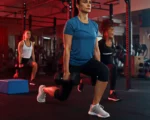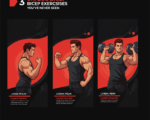The word «toning» is often tossed around in the fitness world. You’ve probably heard it before—claims about workouts designed to «tone your muscles» or promises of achieving a toned body with light weights and endless reps. But what does «toning» actually mean? Is it a real concept in fitness or simply a myth that refuses to fade?
If you’ve been chasing the so-called «toned» look or feel confused about how to achieve muscle definition, this article will clear the air. We’ll walk you through why «toning» as it’s popularly understood is a myth and what it actually takes to achieve your fitness goals.
What Does Toning Really Mean?
Toning, in the most basic sense, refers to firming and strengthening muscles. However, the way fitness marketing has positioned the term can be misleading. Most of the time, when people say they want to «tone,» they mean achieving visible muscle definition without looking «too bulky.»
Here’s the truth: muscle definition comes down to two key factors:
- Increasing muscle size through strength training (muscle growth, aka hypertrophy).
- Reducing body fat to reveal the muscles underneath.
The concept of toning isn’t about a special kind of workout or magical exercise technique; it’s about building muscle and reducing fat. Unfortunately, it’s often marketed as something far simpler, which leads to misunderstanding and, sometimes, ineffective workout programs.
The Light Weights vs. Heavy Weights Myth
One of the most persistent myths about toning is that lifting light weights for a high number of repetitions will give you a «toned» look, while heavy lifting will make you «bulky.» Here’s the truth: muscles don’t differentiate between «toning» and «bulking» exercises.
Muscles can do only three things:
- Grow (hypertrophy).
- Shrink (atrophy).
- Maintain their current size.
Their shape is genetically determined, and you can’t «sculpt» your muscles into a different form. What truly matters isn’t whether you lift light or heavy weights but whether your training includes progressive overload. Progressive overload means gradually increasing the challenge, whether by lifting heavier weights, adding more reps, or improving intensity. This is the foundation of muscle growth, regardless of the weight category.
Without progressive overload, your muscles won’t change significantly, no matter how many «toning» exercises you do.
Why You Can’t Accidentally Get Too Muscular
A common concern among those aiming for a toned physique is the fear of getting «too muscular.» It’s important to understand that building significant muscle requires intensive effort, years of consistent training, and often specific genetics. Contrary to popular belief, it’s not something that happens quickly or easily.
Becoming «muscular» isn’t something you do by accident. Think of it like becoming a millionaire or learning to play an instrument expertly. It takes immense dedication, discipline, and hard work. Lifting heavy weights won’t turn you into a bodybuilder overnight. Instead, it’ll help you develop the muscle definition needed for the toned look you’re after.
The Role of Body Fat
Achieving a «toned» look isn’t just about building muscle. A key factor is reducing the layer of fat that covers those muscles. No matter how much you work out, your muscle definition will be hidden if your body fat percentage is high.
Take the often-cited example of Brad Pitt’s physique in Fight Club or other «toned» celebrity body ideals. Much of that look comes from extremely low body fat (6-10%). This type of conditioning requires significant dietary discipline and a strategic focus on fat loss.
To achieve a similar result:
- Strength Train Regularly to focus on muscle growth.
- Monitor Your Diet to maintain a caloric balance or deficit for fat loss.
- Include Cardio as a complementary way to burn calories.
It’s that combination—not a magical «toning» workout—that creates visible muscle definition.
Train Like a Bodybuilder (Without Fear)
It might surprise you to know that training like a bodybuilder can actually help you achieve the toned look you want. Bodybuilders follow structured workout plans focused on progressive overload, balanced nutrition, and proper recovery. While their goals may include achieving significant muscle size, you don’t have to fear the same outcome. Without their level of intensity or additional «boosts» (like steroids), you’ll simply sculpt a leaner, more defined look over time.
Approaching fitness with this mentality allows for real progress. Instead of spending hours on light weights and ineffective routines, focus on:
- Compound exercises like squats, deadlifts, and rows that target multiple muscle groups.
- Gradually increasing resistance over time.
- Prioritizing muscle recovery with rest and proper nutrition.
If you train with focus and determination, you’ll achieve your personal version of a toned physique.
Building Muscle Can Keep You Lean
A little-known secret in the «toning debate» is that building muscle can help you maintain a leaner physique in the long run. Muscle tissue burns more calories at rest than body fat, meaning the more muscle you build, the higher your resting metabolism. This makes it easier to stay in shape without extreme dieting or hours of cardio.
Muscle also gives your body a defined, athletic appearance—even at slightly higher body fat percentages. It’s the ultimate win-win for both your fitness and aesthetic goals.
Final Thoughts
The myth of toning has persisted largely because it sounds less intimidating and more achievable than «building muscle.» But the truth is, toning and building muscle are one and the same. It’s time to leave the outdated concept of toning behind and focus on what really works:
- Incorporate strength training with progressive overload.
- Adjust your nutrition to support fat loss or maintenance.
- Stay consistent and celebrate the small wins.
If you’re seeking muscle definition, take the leap into effective training without fear of getting «too bulky.» With effort, discipline, and the right mindset, you’ll achieve the results you’re looking for.
Remember, the road to fitness success starts with clarity and understanding. No shortcuts, no myths. Just smart training and dedication.
Whether you’re new to fitness or refining your routine, you’re on the path to a stronger, healthier version of yourself. Start debunking myths and start sculpting confidence instead.








